|
|
 |
Fiche d'espèce de Copépode |
|
|
Cyclopoida ( Ordre ) |
|
|
|
Corycaeidae ( Famille ) |
|
|
|
Farranula ( Genre ) |
|
|
| |
Farranula gracilis (Dana, 1849) (F,M) | |
| | | | | | | Syn.: | Corycaeus gracilis Dana, 1849; 1852; Dahl, 1894 c (p.22, Rem.); F. Dahl, 1894 (p.69); Khalil & Abb El-Rahman, 1997 (p.931);
C. pellucidus Dana, 1849; 1852; Brady, 1883 (p.112, figs.F,M); T. Scott, 1894 b (p.110);
C. deplumatus Dana, 1849; 1852;
C. megalops : Brady, 1883 (p.112);
Corycaeus (Corycella) gracilis : M. Dahl, 1912 (p.108, figs.F,M); Sewell, 1948 (p.393); Marques, 1958 a (p.148); Cervigon, 1964 (p.197, figs.F,M); Binet, 1970 (p.74);
Corycella gracilis : Farran, 1929 (p.211, 296); Rose, 1929 (p.72); Klevenhusen, 1933 a (p.84, chart 34); Owre, 1962 (p.489); Björnberg, 1963 (p.85, Rem.); Gaudy, 1963 (p.33, Rem.); 1967 (p.88); Ramirez, 1971 (p.92); Binet & al., 1972 (p.73); Bainbridge, 1972 (p.61, Appendix Table I: vertical distribution vs day/night, Table II: %, Table IV); Kovalev & Shmeleva, 1982 (p.86); Bityukov & al., 1984 (tab.1); Selifonova, 2011 a (p.77, Table 1, alien species in Black Sea);
C. (Farranula) gracilis : Marques, 1973 (p.250); Böttger-Schnack, 1988 (p.313);
? Corycaeus carinatus : Wheeler, 1901 (p.192, figs.F);
? Corycella carinata : Wilson, 1932 (p.41); 1932 a (p.362, figs.F) | | | | Ref.: | | | Wilson, 1942 a (p.187, fig.F); Gonzalez & Bowman, 1965 (p.267, figs.F,M, Rem.); Owre & Foyo, 1967 (p.124, figs.F,M); Björnberg, 1972 (p.94, figs., Rem.: Nauplius); Marques, 1975 (p.53); Björnberg, 1981 (p.676, fig.F); Boxshall, 1998 (p.223); Bradford-Grieve & al., 1999 (p.888, 975, figs.F,M); Conway & al., 2003 (p.262, figs.F,M, Rem.); Boxshall & Halsey, 2004 (p.493); Vives & Shmeleva, 2010 (p.225, figs.F,M, Rem.); Wi & Soh, 2013 (p.1, Table 1); Fuentes-Reinés & Suarez-Morales, 2017 (p.519, figs.M, Rem.) |  issued from : M. Dahl in Ergebnisse der Plankton-Expedition der Humboldt-Stiftung. Bd II, G. f1. I. Die Corycaeinen 1912. [Taf.XIV, Figs.11, 12]. As Corycaeus (Corycella) gracilis.. Female: 11, habitus (dorsal); 12, idem (lateral right side).
|
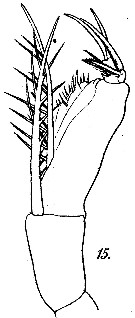 issued from : M. Dahl in Ergebnisse der Plankton-Expedition der Humboldt-Stiftung. Bd II, G. f1. I. Die Corycaeinen 1912. [Taf.XIV, Figs.15]. As Corycaeus (Corycella) gracilis.. Female: 15, A2.
|
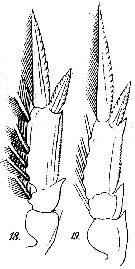 issued from : M. Dahl in Ergebnisse der Plankton-Expedition der Humboldt-Stiftung. Bd II, G. f1. I. Die Corycaeinen 1912. [Taf.XIV, Figs.18, 19]. As Corycaeus (Corycella) gracilis.. Female: 18, P1; 19, P2.
|
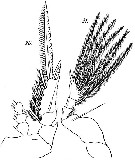 issued from : M. Dahl in Ergebnisse der Plankton-Expedition der Humboldt-Stiftung. Bd II, G. f1. I. Die Corycaeinen 1912. [Taf.XIV, Figs.20, 21]. As Corycaeus (Corycella) gracilis.. Female: 20, P3: 21, P4.
|
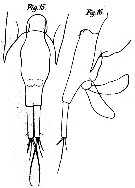 issued from : M. Dahl in Ergebnisse der Plankton-Expedition der Humboldt-Stiftung. Bd II, G. f1. I. Die Corycaeinen 1912. [Taf.XV, Figs.15, 16]. As Corycaeus (Corycella) gracilis.. Female: 15, posterior part of metasome and urosome (dorsal); 16, idem (lateral left side; with spermatophores).
|
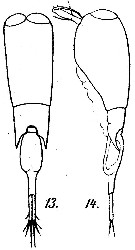 issued from : M. Dahl in Ergebnisse der Plankton-Expedition der Humboldt-Stiftung. Bd II, G. f1. I. Die Corycaeinen 1912. [Taf.XIV, Figs.13, 14]. As Corycaeus (Corycella) gracilis.. Male: 13, habitus (dorsal); 14, idem (lateral left side).
|
 issued from : M. Dahl in Ergebnisse der Plankton-Expedition der Humboldt-Stiftung. Bd II, G. f1. I. Die Corycaeinen 1912. [Taf.XIV, Figs.16, 17]. As Corycaeus (Corycella) gracilis.. Male: 16, A2; 17, Mxp.
|
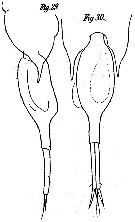 issued from : M. Dahl in Ergebnisse der Plankton-Expedition der Humboldt-Stiftung. Bd II, G. f1. I. Die Corycaeinen 1912. [Taf.XV, Figs.29, 30]. As Corycaeus (Corycella) gracilis.. Male: 29, posterior part of metasome and urosome (lateral right side); 30, idem (dorsal).
|
 issued from : F. Cervigon iin Mem. Soc. Cienc. nat. La Salle, 1964, 24 (68). [p.198, Lam.24]. As Corycella gracilis. Female (Venezuela): 1, prosome (dorsal); 2, habitus (lateral); 3, portion anteroventral of genital segment; 4, A2; 5, P4. Nota: Lengths ratio abdomen and caudal rami 68:32 and 71:29.
|
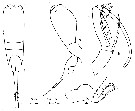 issued from : F. Cervigon iin Mem. Soc. Cienc. nat. La Salle, 1964, 24 (68). [p.19, Lam.25]. As Corycella gracilis. Male: 1-2, habitus (dorsal and lateral, respectively); 3, A2; 4, P4. Nota: Lengths abdomen and caudal rami 67.5:32.5; 67:33 and 69:31.
|
 Female: Urosome about 2 times as long as the caudal rami and, in lateral view, appears more or less humpbacked. In lateral view of the urosome, part of the dorsal margin, before it tapers , lies almost parallel to the ventral margin; the length of this portion of the urosome is about equal to the height of the urosome. Male: Urosome less than 3 times as long as the caudal rami; rami much more than twice as long as broad. Posterior margin of genital enlargements separated from the posterior end of the urosome by more than 1/3 the length of the urosome.
|
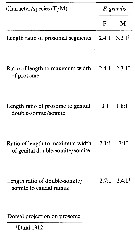 Issued from : J.H. Wi & H.Y. Soh in J. Nat. Hist., 2013. [p.3, Table I]. Length and width proportions of body segments of Farranula gracilis. Nota: Compare with other species of Farranula (on line: http://dx.doi.org/10.1080/00222933.2012.708454).
|
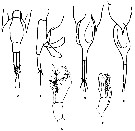 Issued from : F. Vives & A.A. Shmeleva in Fauna Iberica, 2010, 33. [p.104, Fig.113]. After Dahl, 1912. Female: A-B, abdomen (dorsal and lateral, respectively); C, A2; Male: D-E, abdomen (dorsal and lateral, respectively); F, A2.
|
 Issued from : F. Vives & A.A. Shmeleva in Fauna Iberica, 2010, 33. [p.227, Fig.104]. After Dahl, 1912. Female: A-B, abdomen (dorsal and lateral,); B, abdomen; C, A2; D, P4. Male: E, abdomen; F, A2.
|
 Issued from : J.M. Fuentes-Reinés & E. Suarez-Morales in Check List, 2017, 13 (5). [p.520, Figs. 22-24]. Male (from Rodadero Bay, N Colombia): 22, forehead showing apical ocular lenses; 23, P4; 24, urosome and caudal rami (ventral view). Noya: Exopod of P4 3-segmented, lacking endopod.
| | | | | Ref. compl.: | | | C.B. Wilson, 1950 (p.228); Fagetti, 1962 (p.50); Grice & Hart, 1962 (p.287, table 4: abundance); Grice, 1963 a (p.496); Neto & Paiva, 1966 (p.34, Table III); Deevey, 1971 (p.224); Björnberg, 1973 (p.369, 386); Boxshall, 1977 b (p.556); Deevey & Brooks, 1977 (p.156, tab.2, Station "S"); Binet, 1979 (p.400); Dessier, 1979 (p.131, 202, 208); Vives, 1982 (p.296); Turner & Dagg, 1983 (p.17, 22); Greze & al., 1985 (p.8); Lindo, 1991 (tab.3); Webber & Roff, 1995 a (p.481, table 1, 2, 3, biomass, production); Böttger-Schnack, 1995 (p.92); Webber & al., 1996 (tab.1); Suarez-Morales & Gasca, 1997 (p.1525); Alvarez-Cadena & al., 1998 (t.1,2,3,4); Hopcroft & al., 1998 (tab.2); Lopes & al., 1998 (p.195, tab.2); Suarez-Morales & Gasca, 1998 a (p.112); Lopes & al., 1999 (p.215, tab.1); Lavaniegos & Gonzalez-Navarro, 1999 (p.239, Appx.1); Neumann-Leitao & al., 1999 (p.153, tab.2); Razouls & al., 2000 (p.343, tab. 5, Appendix); Suarez-Morales & Gasca, 2000 (1247, tab.1); Lopez-Salgado & al., 2000 (tab.1); Dunbar & Webber, 2003 (tab.1); Camisotti & al., 2005 (p.99); Alvarez-Silva & al., 2005 (p.39); Sterza & Fernades, 2006 (p.95, Table 1, occurrence); Dias & Araujo, 2006 (p.85, Rem., chart); Neumann-Leitao & al., 2008 (p.799: Tab.II, fig.6); Morales-Ramirez & Suarez-Morales, 2008 (p.516, 525); Miyashita & al., 2009 (p.815, Tabl.II); Lidvanov & al., 2010 (p.356, Table 3); Dias & al., 2010 (p.230, Table 1); Medellin-Mora & Navas S., 2010 (p.265, Tab. 2); Shiganova & al., 2012 (p.61, Table 4); Uysal & Shmeleva, 2012 (p.909, Table I); Lidvanov & al., 2013 (p.290, Table 2, % composition); Bonecker & a., 2014 (p.445, Table II: frequency, horizontal & vertical distributions); Marquez-Rojas & al., 2014 (p.13, Rem., %); Dias & al., 2015 (p.483, Table 2, abundance, biomass, production, Table 4: % vs. season); Rojas-Herrera & al., 2016 (p.40, Table 2: temporal abundance); Zakaria & al., 2016 (p.1, Table 1, Rem.) Ben Ltaief & al., 2017 (p.1, Table III, Summer relative abundance) ; Marques-Rojas & Zoppi de Roa, 2017 (p.495, Table 1); Bonecker C.T. & al., 2017 (p.247, fig.7: abundance day/night vs. vertical types of mass water); Abo-Taleb & Gharib, 2018 (p.139, Table 5, occurrence %); Dias & al., 2018 (p.1, Tables 2, 4, 5: vertical distribution, abundance vs. season); Palomares-Garcia & al., 2018 (p.178, Table 1: occurrence); Acha & al., 2020 (p.p.1, Table 3: occurrence % vs. ecoregions). | | | | NZ: | 19 | | |
|
Carte de distribution de Farranula gracilis par zones géographiques
|
| | | | | | | | | | | | | | |  issued from : H.B. Owre & M. Foyo in Fauna Caribaea, 1, Crustacea, 1: Copepoda. Copepods of the Florida Current. 1967. [p.124, Table 66]. issued from : H.B. Owre & M. Foyo in Fauna Caribaea, 1, Crustacea, 1: Copepoda. Copepods of the Florida Current. 1967. [p.124, Table 66].
Vertical distribution of Farranula gracilis at the ''40-Mile station'' in the Florida Current (E Miami: ± 25°35'N, 79°27'W).
SL 53: 18 V 1958; A: during midday; B: during midnight. |
 Issued from : A.C.T. Bonecker, A. V. de Araujo, C.O. Dias, M.M.S. Castro, P.F. Carvalho, R.M. Lopes & S.C.L. Bonecker in A.P.C. Falcao & D.L. Moreira (ed.) Ambiente pelagico caracterizaçao ambiental regional de Bacia de Campos, Atlantico Sudoeste. Rio de Janeiro. Elsevier. 2017, v.5, p.247-281. [p.259, Fig.7] Issued from : A.C.T. Bonecker, A. V. de Araujo, C.O. Dias, M.M.S. Castro, P.F. Carvalho, R.M. Lopes & S.C.L. Bonecker in A.P.C. Falcao & D.L. Moreira (ed.) Ambiente pelagico caracterizaçao ambiental regional de Bacia de Campos, Atlantico Sudoeste. Rio de Janeiro. Elsevier. 2017, v.5, p.247-281. [p.259, Fig.7]
Abundance (ind. m-3) sampled during night and day into four water masses in the Campos Basin (Brazil).
AT: Tropical water; ACAS: Central water of South Atlantic; AIA: Intermediate water of Antarctica; ACS: Deep water Circumpolar water superior.
Sampling at station c (22°54'30''S, 40°43'W), depth 1900 m (end of the continental slope).
Nota: On 117 taxa, with 81 species identified, this species is the most abundant (765,25 ind.m-3), following by Clausocalanus furcatus (433,47 ind.m-3). |
 Issued from : M.K. Webber & J.C. Roff in Mar. Biol., 1995, 123. [p.484, Table 1]. Issued from : M.K. Webber & J.C. Roff in Mar. Biol., 1995, 123. [p.484, Table 1].
Length-weight regression of Farranula gracilis in oceanic waters of Discovery Bay (Jamaica) in 60- and 200 m vertical hauls, using 200- and 64-µm mesh aperture of plankton nets, from June 1989 to July 1991 (monthly samples). |
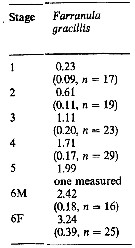 Issued from : M.K. Webber & J.C. Roff in Mar. Biol., 1995, 123. [p.485, Table 2]. Issued from : M.K. Webber & J.C. Roff in Mar. Biol., 1995, 123. [p.485, Table 2].
Main biomass (µg) of copepodite stages for Farranula gracilis, with standard deviation and n number of individuals measured. |
 Issued from : M.K. Webber & J.C. Roff in Mar. Biol., 1995, 123. [p.485, Table 3]. Issued from : M.K. Webber & J.C. Roff in Mar. Biol., 1995, 123. [p.485, Table 3].
Stage weight increments (In mmax mmin-1) for Farranula gracilis, calculated from mean biomass of each stage. |
| | | | Loc: | | | Antarct. (Ross Sea), sub-Antarct. (SW Pacif.), Angola, Baia Farta, Congo, San Tomé et Principe Is., G. of Guinea, off Lagos, Ivorian shelf, Patagonia, Brazil (S, off Rio de Janeiro, Campos Basin, Vitoria Bay, Vitoria-Cabo de Sao Tomé, off Macaé, off Natal, Amazon), Cape Verde Is., off Morocco-Mauritania, off Madeira, Barbada Is., Caribbean Sea, Caribbean Colombia, Rodadero Bay, Bahia de Mochima & Cariaco Gulf (Venezuela), Yucatan, Venezuela, Jamaica (Kingston Harbour), Porto Rico, E Costa Rica, G. of Mexico, Cuba, Florida, Long Island, Sargasso Sea, off Bermuda (Station "S"), off W Azores, Medit. (Alboran Sea, Gulf of Gabes, Ioniann-Cyprus, W Egyptian coast, N Lebanon Basin, Black Sea), Red Sea (G. of Aqaba, Hurghada), Natal, Maldive Is., Madagascar, S Indian, Philippines, China Seas, off S New Zealand, Fidji Is., off Hawaii, Galapagos, off Washington, California, S Baja California (La Paz), G. of California, Acapulco Bay, Zihuatanejo Bay, W Costa Rica, Equador, N Chile, Bering Sea. | | | | N: | 93 | | | | Lg.: | | | (35) [Atlant. trop.] F: 0,96-0,9; M: 0,96-0,8; [Atlant. N] F: 0,79; M: 0,75-0,66; [Antarct.] F: 0,99; (179) F: 0,94; (237) F: 0,93-1,1; M: 0,8-1,0; (336) F: 1,1-0,9; M: 0,9-0,7; (618) F: 1,03-0,93; M: 0,86-0,83; (651) F: 0,99-0,92; M: 0,89-0,77; (666) F: 1; M: 0,8; (668) F: 0,98-0,96; M: 0,92-0,86; (991) F: 0,96-0,98; M: 0,86-0,92; (1313) M: 0,756-0,812; {F: 0,79-1,10; M: 0,66-1,00} | | | | Rem.: | épi-méso-bathypélagique.
Sampling depth (Antarct.) : 0-450 m.
See remark on Farranula carinata.
Voir aussi les remarques en anglais | | | Dernière mise à jour : 13/11/2020 | |
|
|
 Toute utilisation de ce site pour une publication sera mentionnée avec la référence suivante : Toute utilisation de ce site pour une publication sera mentionnée avec la référence suivante :
Razouls C., Desreumaux N., Kouwenberg J. et de Bovée F., 2005-2025. - Biodiversité des Copépodes planctoniques marins (morphologie, répartition géographique et données biologiques). Sorbonne Université, CNRS. Disponible sur http://copepodes.obs-banyuls.fr [Accédé le 26 août 2025] © copyright 2005-2025 Sorbonne Université, CNRS
|
|
 |
 |




















